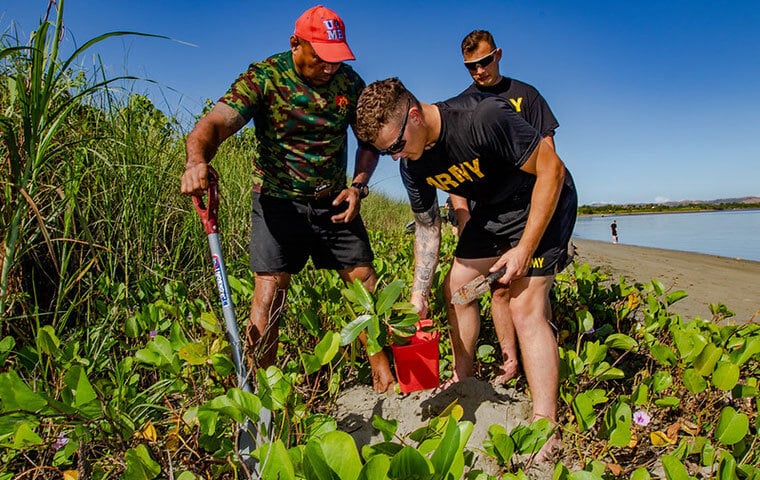 A Fijian Army Sgt. plants dilo trees with Army Specialists with the 1st Btn., 27th Inf. Regt., 25th Inf. Division, during a coastal and reef revitalization project during Exercise Cartwheel 2019, near Nadi, Fiji, Aug. 13. Part of both the Republic of Fiji Military Forces and the U.S. Indo-Pacific Command's defense strategy is to addresses climate change. The planting of palms, dilo trees and mangroves was an effort to strengthen the coastline with root systems that prevents local silt from pummeling the nearby barrier reef. (US Army photo.)
By: FEDweek Staff
A Fijian Army Sgt. plants dilo trees with Army Specialists with the 1st Btn., 27th Inf. Regt., 25th Inf. Division, during a coastal and reef revitalization project during Exercise Cartwheel 2019, near Nadi, Fiji, Aug. 13. Part of both the Republic of Fiji Military Forces and the U.S. Indo-Pacific Command's defense strategy is to addresses climate change. The planting of palms, dilo trees and mangroves was an effort to strengthen the coastline with root systems that prevents local silt from pummeling the nearby barrier reef. (US Army photo.)
By: FEDweek StaffThe Army is undergoing a modernization plan aimed at mitigating the effects of climate change. The issue demands attention now, the service’s leadership believes.
“For today’s soldiers operating in extreme temperature environments, fighting wildfires, and supporting hurricane recovery, climate change isn’t a distant future, it is a reality,” Secretary of the Army Christine E. Wormuth said. “The effects of climate change have taken a toll on supply chains, damaged our infrastructure, and increased risks to Army soldiers and families due to natural disasters and extreme weather.”
The Army’s strategy would not alter its core mission – to deploy and fight wars from a position of dominance. Rather, it would entail doing so while:
• Achieving a 50-percent reduction in greenhouse gas (GHG) pollution by 2030, compared to 2005 levels.
• Achieving zero GHG emissions by 2050.
• Factoring the security implications of climate change when formulating strategy, planning acquisitions, maintaining the supply chain, and programming documents and processes.
Soldiers should begin seeing microgrids installed at installations, power plants that have no reliance on carbon-based polluters and a fleet of all-electric light and heavy non-tactical vehicles. In time, the plan would expand to include tactical vehicles, further reduce carbon pollution to the point where it disappears by 2050, reduce water and operational energy consumption, and make plans that ensure “supply chain resilience.”
“Bold actions now will ensure the Army is ready to support our nation in competition, crisis, and conflict far into the future,” the service stated.
Ban on Vaccine Mandate Stays in Effect, at Least for Now
VA Program of Comprehensive Assistance for Family Caregivers Now Eligible for Judicial Review
Line of Duty Determinations: Why You Need Them and What to Do if You Don’t Have One
VA Changes Debt-Reporting Procedure

